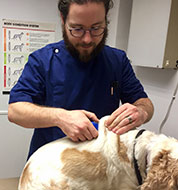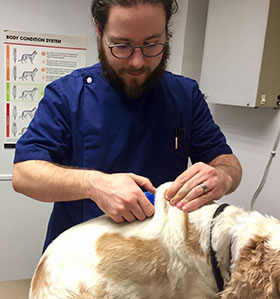

Photo by Siobhan Delahaye
Dr. Elliot Kneba inserts a microchip in a patient. Microchipping of dogs became mandatory in England, Scotland and Wales last April.
Less than a year since Great Britain mandated that all dogs be microchipped, British officials say the law has met with near-universal compliance.
The British government began last spring to enforce a requirement that all canines eight weeks and older be outfitted with microchip identification, in part to lower the number of stray, undocumented dogs. By September, an estimated 94 percent of dogs in England, Scotland and Wales had been chipped, said Gaye Halliday, spokesperson for the Department for Environment, Food & Rural Affairs (DEFRA).
Halliday said the compliance rate equates to roughly 8 million dogs with chips, based on the Pet Food Manufacturers Association estimate of 8.5 million dogs in the affected countries. Halliday said the government considers a dog chipped after it’s had a chip inserted and its keeper’s information is entered in a database.
In 2013, when the government began a campaign to inform the public of the mandate that would take effect on April 6, 2016, it reported that not quite 60 percent of dogs were chipped.
Environment Secretary Owen Paterson said in a prepared statement at the time: “It’s a shame that in a nation of dog lovers, thousands of dogs are roaming the streets or stuck in kennels because the owner cannot be tracked down. I am determined to put an end to this and ease the pressure on charities and councils to find new homes for these dogs.”
More than 100,000 unchipped dogs were dumped or lost each year, the government said. Caring for or exterminating those animals cost an estimated 57 million pounds, equivalent to about $72 million.
An annual survey conducted by Dogs Trust, a dog-welfare charity, found that the number of strays had declined to 81,000 in 2016, compared with 126,000 in 2011.
More than 86 percent of dogs were chipped by the time the mandate went into effect last April, government officials reported. Education about the approaching deadline and widespread efforts to help dog owners become compliant presumably drove the significant increase in chipped dogs compared with three years earlier.
Dr. Elliot Kneba, a practitioner in Hertfordshire, England, said the legislation has prodded people with unchipped dogs to get their dogs chipped. Furthermore, making shelters and breeders responsible for chipping dogs in their care helps ensure that new and future owners are compliant, and, Kneba said, offers to new owners the convenience of obtaining pets that already are chipped. Overall, he said, the law “has been well-received.”
The keeper of an unchipped dog can be fined up to 500 pounds, or about $630. DEFRA said in April that people found to be in violation would first have the benefits of microchipping explained to them and given a short period of time to comply.
The mandate covers dogs in England, Scotland and Wales and is modeled on a similar effort in Northern Ireland, where microchipping has been required since 2012.
(The DEFRA website notes that rules in Scotland differ from those in England and Wales; a Scottish government official explained that the difference pertains only to database operators.)
The initiative has received high marks from veterinarians, said Dr. Stijn Niessen, deputy clinical director for small animal referrals at the Royal Veterinary College in London. Part of what has made the law work, he said, is “widespread backing [from] professionals and lay public.” Niessen believes that requiring microchips encourages responsible pet ownership.
Dr. Gudrun Ravetz, president of the British Veterinary Association (BVA), said her organization was part of a coalition that campaigned for compulsory microchipping.
Monetary support from animal charities also might have played a role in the program's success. The Dogs Trust, the United Kingdom’s largest canine welfare charity, provided chips for free at its 18 locations. So did another animal welfare organization, Blue Cross, through its 16 centers.
Owners who eschewed free chips paid between 10 to 30 pounds (about $12 to $37), depending on where they obtained the service.
Microchips, which roughly are the size of a grain of rice, are inserted with a handheld device beneath the skin between an animal’s shoulder blades. Each chip carries a unique number communicated through a radio signal detectable by a microchip scanner. A chipped dog picked up as a stray can have its chip scanned to identify and locate its keeper — provided, that is, that the chip number has been registered and the registration is up-to-date.
The law requires people who keep dogs to register their dog’s chip and keep information current. That last part, keeping the information current, doesn't always happen.
This is where the program, in spite of its high success, has room for improvement, Ravetz said. “Dogs Trust research [has shown] that the leading reason microchipped dogs couldn’t be reunited with their owners was because the owner’s details on the microchip database had not been updated,” she said.
In the United States, where the dog population is eight or nine times the size of Great Britain’s, there is no similar effort to compel pet microchipping. The U.S. pet microchipping scene is a Gordian knot of conflicting business interests that, even with concerted effort, pet lovers and veterinary organizations have failed to untangle.
The problems range from variations in chip radio frequencies and inability of some scanners to read all chips; to difficulty determining which particular chip registry houses a particular animal’s identity and ownership information.
The use of microchips also has been known to raise sticky questions about ownership. In the case of a found animal, for example, is the true owner the person in possession of the animal or the person to whom the animal is registered?
The British law does not attempt to answer that question. According to information posted by Petlog, the United Kingdom’s largest database for microchipped pets, a microchip does not serve as proof of ownership. “The words ‘owner’ and ‘ownership’ have been replaced [in the law] by the words ‘keeper’ and ‘keepership’ for this very reason,” Petlog notes.
The law defines a keeper several ways, depending on the context. In the case of a dog that isn’t a young puppy or an assistance dog, its keeper is “the person with whom it normally resides.”
As in Great Britain, another problem in the United States associated with the use of microchips is that of owners failing to keep their registry information current.
A Silicon Valley entrepreneur who tried for six years to streamline the system gave up in 2015, saying, “I just firmly believe that it cannot be fixed."
The American Animal Hospital Association maintains an online pet microchip lookup tool to help finders of chipped animals identify what registry has the animal’s information. But for competitive reasons, not all companies participate.
Ravetz with the BVA said that in Britain, such confusion rarely is a problem. While there are seven microchip databases, any of the seven contacted will provide advice on which database contains the animal’s registration data. Moreover, she said, “although there are also different microchips in the U.K., most scanners owned by vets and local authorities are able to read both chip types.”
Kneba concurred, noting that microchip companies in the U.K. allow free searches on their websites for owners and finders of stray animals. The companies also offer veterinary clinics free account registration, he said, so staff can search for a chip on an online database without having to call in.
Kneba attributed the effectiveness of the microchip mandate to the long length of time that veterinarians, local authorities and news organizations informed owners and microchip companies of the legislation. Without that multi-pronged effort, he doubted the near-total compliance would have been reached.
“Rules are nothing without education and enforcement,” Kneba said.